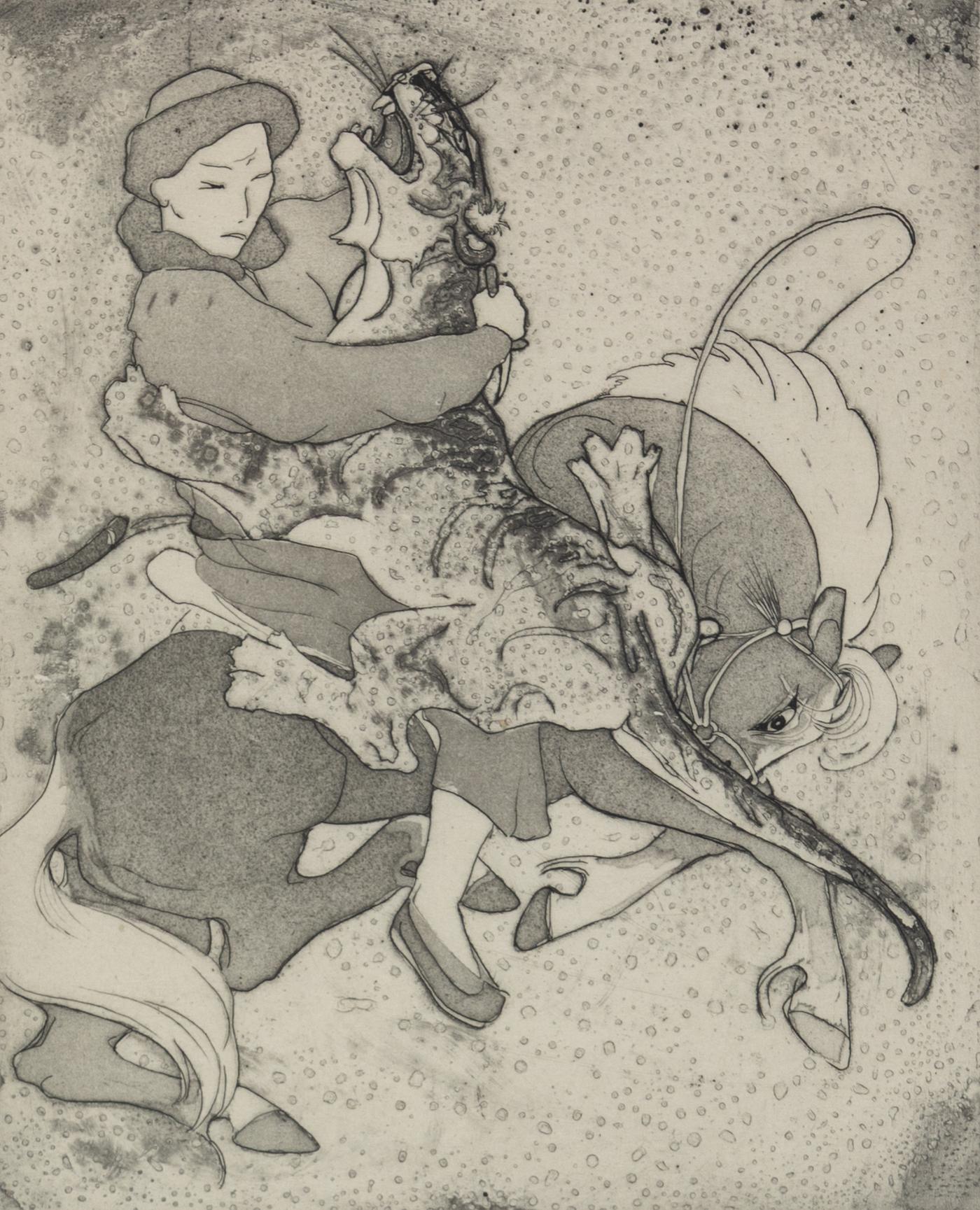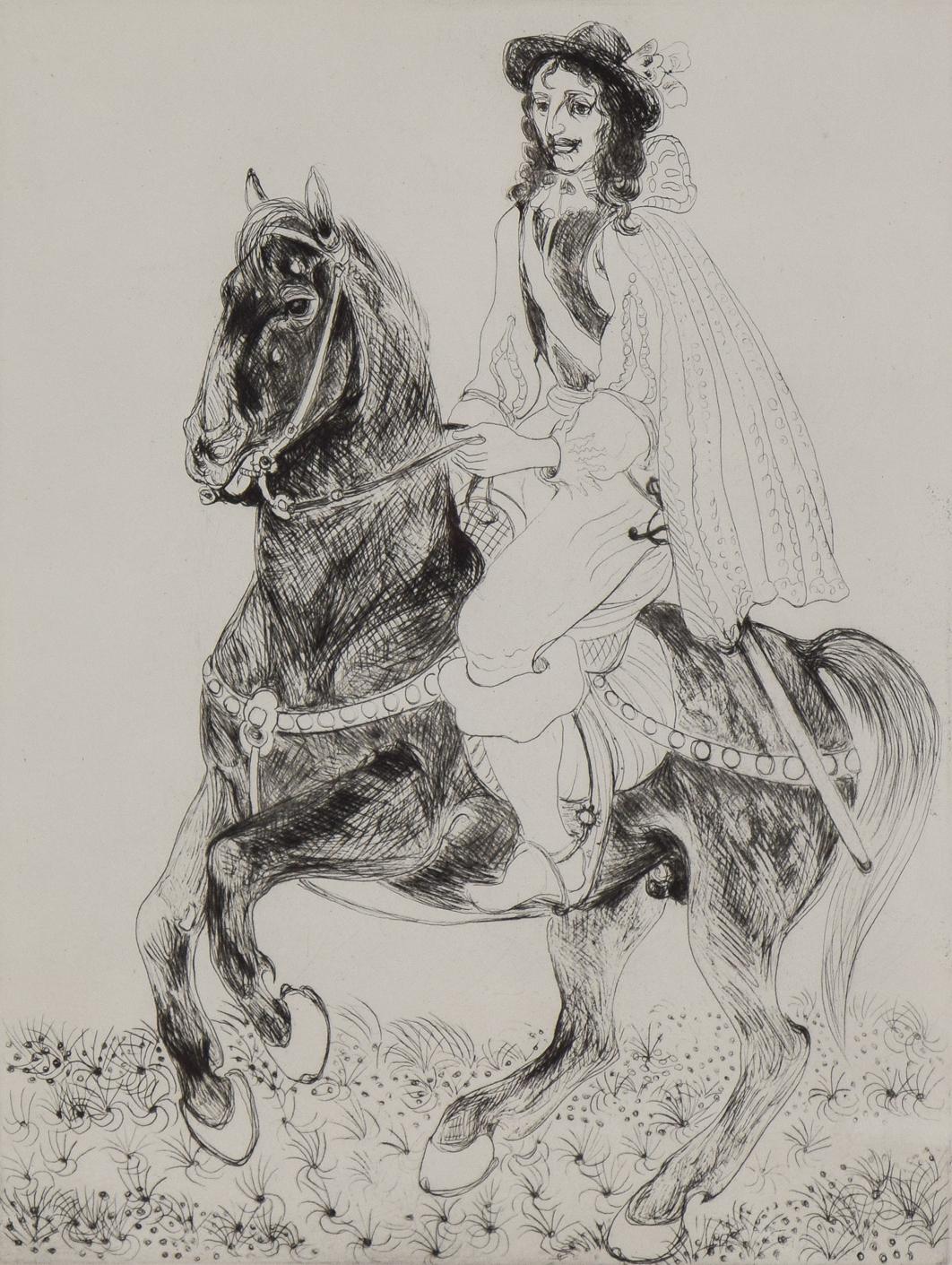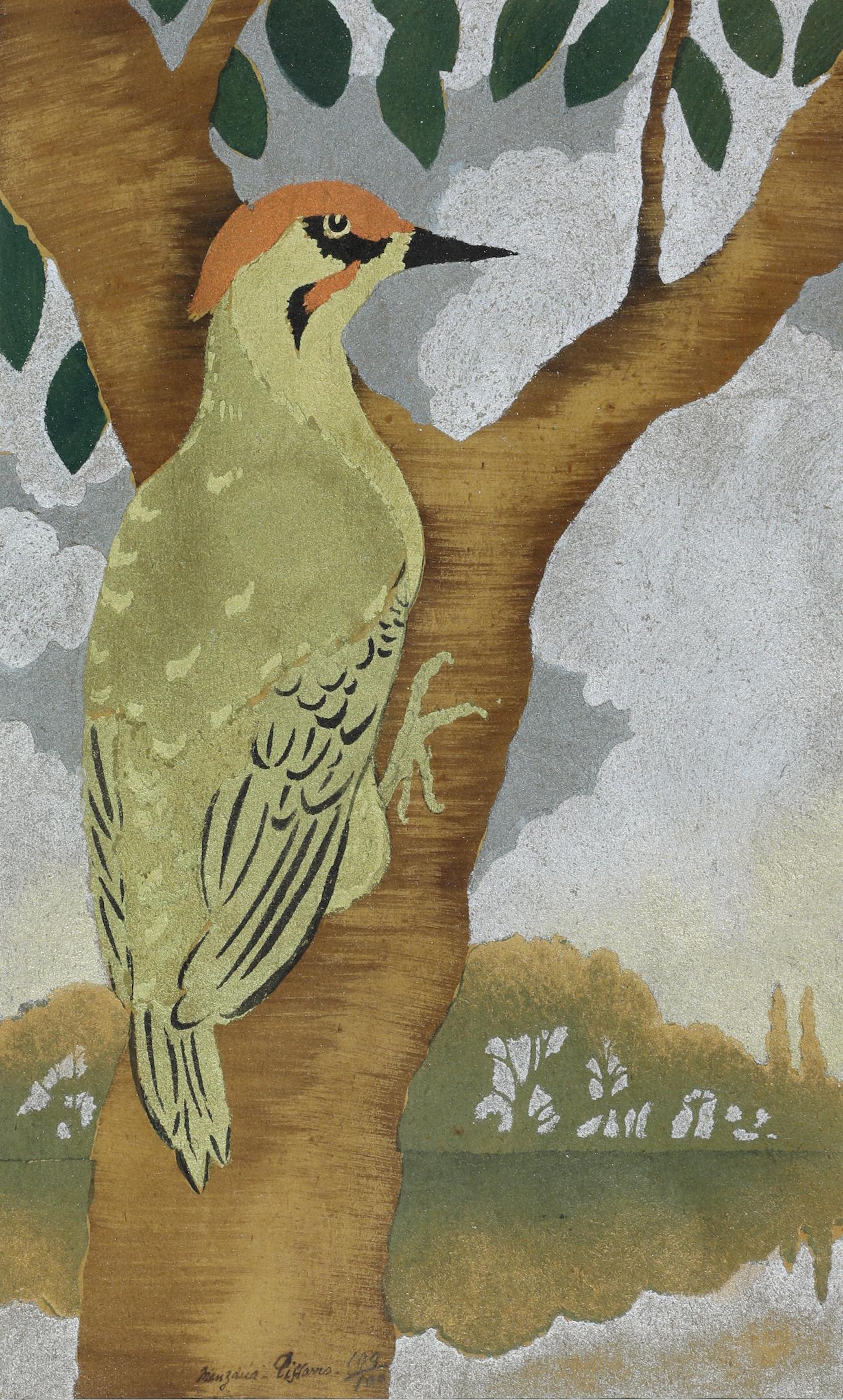Marie LaurencinLithograph Lady Rider Woman on a Horse Marie Laurencin French Post Impressionist
About the Item
- Creator:Marie Laurencin (1883-1956, French)
- Dimensions:Height: 19.75 in (50.17 cm)Width: 23.5 in (59.69 cm)
- Medium:
- Movement & Style:
- Period:
- Condition:light toning, please see photos.
- Gallery Location:Surfside, FL
- Reference Number:1stDibs: LU38211932822
Marie Laurencin
Artist Marie Laurencin is best known for her enchanting portraits of women and young girls. The Parisian artist was linked to the avant-garde Cubist movement, but she endeavored to disassociate herself from the style as she instead drew on the Impressionist style of Pierre-Auguste Renoir in her paintings and prints, and created poetic, overtly sensual images of women in Fauvism’s subdued pastels at a time when the leagues of male artists around her became famous for making still lifes.
Just as Renoir and other painters began their careers painting pottery in Limoges, Laurencin trained in porcelain painting in the southwestern suburbs of Paris before she studied oil painting at Académie Humbert alongside influential Cubist painter Georges Braque and French designer and painter Francis Picabia. Her circle consisted of widely known and reputable artists including Braque and Pablo Picasso, with whom she exhibited. Her romantic partners were both male and female over the years, and she repeatedly refused marriage proposals from the most famous art dealer at the time, Sir Joseph Duveen, Baronet. Laurencin had a romantic relationship with French poet Guillaume Apollinaire that lasted six years.
Laurencin produced most of her best known work throughout the 1920s. During this era, she worked with art dealer Paul Rosenberg although she frequently ignored his business advice. Known to only paint children she liked, Laurencin also charged men twice that of women, as well as brunettes more than blondes, and offered discounts for works she enjoyed doing and steeper prices for those she cared less for.
Laurencin’s work increasingly attracted attention over time — she had more than ten solo exhibitions in 1939 alone and was commissioned for portraits by the likes of Jean Cocteau and Coco Chanel. (Revered fashion designer Karl Lagerfeld — who consistently displayed a knack for synthesizing old and new, high and low — drew on the work of Laurencin in his Spring/Summer 2011 collection for Chanel.)
Laurencin’s six illustrations of "Alice" in a 1930 edition of Lewis Carroll's Alice in Wonderland comprise a small sample of the art she made that is held in the public collection of the Museum of Modern Art. Her works are also held in the collections of the Metropolitan Museum of Art, the Musée d’Orsay and the National Museum of Women in the Arts. In 1983, a museum opened in her honor — the Musée Marie Laurencin in Nagano, Japan. At the time, it was the only museum in the world to focus solely on a female painter.
Find original Marie Laurencin paintings and prints on 1stDibs.
- ShippingRetrieving quote...Ships From: Surfside, FL
- Return PolicyA return for this item may be initiated within 3 days of delivery.
- Israeli Modern Hanukkah Lithograph Silkscreen David Sharir Holiday Serigraph ArtBy David SharirLocated in Surfside, FLThis is a mixed lithograph and serigraph silkscreen as per descriptions i read. this is not signed or numbered and is marked sample. it is a rare artists or printers proof print. David Sharir was born in 1938 in Tel Aviv, Israel and currently resides there. David Sharir, the son of Russian immigrants, was born in Israel. Beginning his study of art in Tel Aviv and continuing in Florence and Rome, where he studied architecture and theater design. The brightly colored costumes and intricate stage designs he created for these productions have profoundly influenced his art. When Sharir moved to Jaffa in 1966, his hallmark style was truly developed. Studio, family, and spiritual devotion all serve as inspiration for the imagery in his work. His evolving style combines personal experience, Biblical symbolism, and fantasy. David Sharir, born 1938, Tel Aviv. Was among the first artists to settle in Old Jaffa in 1966. He depicted biblical subjects with a touch of humour and designed sets and costumes for the theatre and opera. Graphic Art in Israel Today Tel Aviv Museum, Tel Aviv 1973 Israel 1948-1958: Watercolors, Drawings, Graphics The Bezalel National Museum, Jerusalem 1958 Jean David, Yosl Bergner, Menachem Shemi, Zvi Mairovich, Ruth Schloss, Nahum Gutman, Moshe Elazar Castel...Category
20th Century Contemporary Figurative Prints
MaterialsLithograph
- Israeli Modern Passover Lithograph Silkscreen David Sharir Holiday Art SerigraphBy David SharirLocated in Surfside, FLThis is a mixed lithograph and serigraph silkscreen as per descriptions i read. this is not signed or numbered. it is a rare artists or printers proof print. It depicts Moses and Aaron at the top and I believe it relates to Passover and the exodus from Egypt. David Sharir was born in 1938 in Tel Aviv, Israel and currently resides there. David Sharir, the son of Russian immigrants, was born in Israel. Beginning his study of art in Tel Aviv and continuing in Florence and Rome, where he studied architecture and theater design. The brightly colored costumes and intricate stage designs he created for these productions have profoundly influenced his art. When Sharir moved to Jaffa in 1966, his hallmark style was truly developed. Studio, family, and spiritual devotion all serve as inspiration for the imagery in his work. His evolving style combines personal experience, Biblical symbolism, and fantasy. David Sharir, born 1938, Tel Aviv. Was among the first artists to settle in Old Jaffa in 1966. He depicted biblical subjects with a touch of humour and designed sets and costumes for the theatre and opera. Graphic Art in Israel Today Tel Aviv Museum, Tel Aviv 1973 Israel 1948-1958: Watercolors, Drawings, Graphics The Bezalel National Museum, Jerusalem 1958 Jean David, Yosl Bergner, Menachem Shemi, Zvi Mairovich, Ruth Schloss, Nahum Gutman, Moshe Elazar Castel...Category
20th Century Contemporary Figurative Prints
MaterialsLithograph
- Israeli Modern Tu BiShvat Lithograph Silkscreen David Sharir Holiday SerigraphBy David SharirLocated in Surfside, FLThis is a mixed lithograph and serigraph silkscreen as per descriptions i read. this is not signed or numbered. it is a rare artists or printers proof print. David Sharir was born in 1938 in Tel Aviv, Israel and currently resides there. David Sharir, the son of Russian immigrants, was born in Israel. Beginning his study of art in Tel Aviv and continuing in Florence and Rome, where he studied architecture and theater design. The brightly colored costumes and intricate stage designs he created for these productions have profoundly influenced his art. When Sharir moved to Jaffa in 1966, his hallmark style was truly developed. Studio, family, and spiritual devotion all serve as inspiration for the imagery in his work. His evolving style combines personal experience, Biblical symbolism, and fantasy. David Sharir, born 1938, Tel Aviv. Was among the first artists to settle in Old Jaffa in 1966. He depicted biblical subjects with a touch of humour and designed sets and costumes for the theatre and opera. Graphic Art in Israel Today Tel Aviv Museum, Tel Aviv 1973 Israel 1948-1958: Watercolors, Drawings, Graphics The Bezalel National Museum, Jerusalem 1958 Jean David, Yosl Bergner, Menachem Shemi, Zvi Mairovich, Ruth Schloss, Nahum Gutman, Moshe Elazar Castel...Category
20th Century Contemporary Figurative Prints
MaterialsLithograph
- Modern Israeli Lithograph Reuven Rubin Views Of Israel Judaica Crowing RoosterBy Reuven RubinLocated in Surfside, FLLithograph printed by Chez Daniel Jacomet, Paris, France 1960 offset lithograph in colors on Arches, signed in crayon on the justification sheet (this auction is just for the one lit...Category
1960s Modern Figurative Prints
MaterialsLithograph, Offset
- Surrealist Salvador Dali Large Pochoir Etching Drypoint Lithograph Chariot RiderBy Salvador DalíLocated in Surfside, FLSalvador Dalí (1904-1989) – Spanish painter, graphic artist and sculptor. Drypoint with etching and pochoir on Japon paper "Elijah and the Chariot," 1975, (Horse and rider) from the "Our Historical Heritage" suite. Pencil signed along the lower right and numbered 53/250 along the lower left. Literature: Field 75-4 J Framed; Height: 29 in x width: 35 in. Mat opening 19.5 X 25.5. The Spanish artist’s extensive oeuvre not only includes watercolors, drawings and sculptures but also tapestries; here a fine example from the limited edition ‘The Twelve Tribes of Israel’ The tapestry was created after an etching by Salvador Dalí from 1973 with the title ‘The Tribe of Judah’, which the artist created as part of a suite to mark the 25th anniversary of the State of Israel, and in which he represented the twelve tribes of Israel. This vintage French tapestry is an impeccable textile re-creation of a rare Dali etching. This is a flat weave Aubusson style tapisserie. The edition size was 500. The tapestry is inscribed with woven ‘Salvador Dalí’ lower right Genre: Surrealism Subject: people, architecture rendering Medium: textile Salvador Dali (Spanish, 1904-1989) Salvador Dali is considered as the greatest original artist of the surrealist art movement and one of the greatest masters of art of the twentieth century. Dali began to study art at the Royal Academy of Art in Madrid. He was expelled twice and never took the final examinations. His opinion was that he was more qualified than those who should have examined him. In 1928 Dali went to Paris where he met the Spanish painters Pablo Picasso and Joan Miro. He established himself as the principal figure of a group of surrealist artists grouped around Andre Breton, who was something like the theoretical "schoolmaster" of surrealism. Years later Breton turned away from Dali accusing him of support of fascism, excessive self-presentation and financial greediness. By 1929 Dali had found his personal style that should make him famous - the world of the unconscious that is recalled during our dreams. The surrealist theory is based on the theories of the psychologist Dr. Sigmund Freud. Recurring images of burning giraffes and melting watches became the artist's surrealist trademarks. Along with Rene Magritte his is considered the greatest of the Surrealists. His great craftsmanship allowed him to execute his paintings in a nearly photo realistic style. No wonder that the artist was a great admirer of the vintage Italian Renaissance painter Raphael. Meeting Gala was the most important event in the artist's life and decisive for his future career. She was a Russian immigrant and ten years older than Dali. When he met her, she was married to Paul Eluard. In 1933 Salvador Dali had his first one-man show in New York. One year later he visited the U.S. for the first time supported by a loan of US$500 from Pablo Picasso. To evade World War II, Dali chose the U.S.A. as his permanent residence in 1940. He had a series of spectacular exhibitions, among others a great retrospective at the Museum of Modern Art in New York. He has worked in paining, sculpture, tapestry, Daum glass and prints. Dali became the darling of the American High Society. Celebrities like Jack Warner or Helena Rubinstein gave him commissions for portraits. His artworks became a popular trademark and besides painting he pursued other activities - jewelry and dated clothing designs for Coco Chanel or film making with Alfred Hitchcock. In 1948 Dali and Gala returned to Europe, spending most of their time either in their residence in Ligate/Spain or in Paris/France or in New York. Dali developed a lively interest in science, religion and history. He integrated things into his art that he had picked up from popular science...Category
1970s Surrealist Figurative Prints
MaterialsDrypoint, Etching, Lithograph
- Contemporary Indian Art Master Lithograph in Color Abstract Figures with CatBy Sakti BurmanLocated in Surfside, FLCircus scene with cat, lithograph. (possibly colored with watercolor painting. I am not sure) Sakti Burman (born 1935 in Kolkata) is a contemporary Indian artist of Indian parentag...Category
1960s Contemporary Figurative Prints
MaterialsLithograph
- Man & Beast by Orovida Pissarro - EtchingBy Orovida PissarroLocated in London, GB*UK BUYERS WILL PAY AN ADDITIONAL 20% VAT ON TOP OF THE ABOVE PRICE Man & Beast by Orovida Pissarro (1893-1968) Etching 27 x 22 cm (10 ⁵/₈ x 8 ⁵/₈ inches) Signed and dated lower right, orovida 1924 Inscribed lower left, Final state no 12/40 and titled lower centre Artist biography: Orovida Camille Pissarro, Lucien and Esther Pissarro’s only child, was the first woman in the Pissarro family as well as the first of her generation to become an artist. Born in Epping, England in 1893, she lived and worked predominantly in London where she became a prominent member of several British arts clubs and societies. She first learned to paint in the Impressionist style of her father, but after a brief period of formal study with Walter Sickert in 1913 she renounced formal art schooling. Throughout her career, Orovida always remained outside of any mainstream British art movements. Much to Lucien's disappointment she soon turned away from naturalistic painting and developed her own unusual style combining elements of Japanese, Chinese, Persian and Indian art. Her rejection of Impressionism, which for the Pissarro family had become a way of life, together with the simultaneous decision to drop her famous last name and simply use Orovida as a ‘nom de peintre’, reflected a deep desire for independence and distance from the weight of the family legacy. Orovida's most distinctive and notable works were produced from the period of 1919 to 1939 using her own homemade egg tempera applied in thin, delicate washes to silk, linen or paper and sometimes embellished with brocade borders. These elegant and richly decorative works generally depict Eastern, Asian and African subjects, such as Mongolian horse...Category
1920s Post-Impressionist Animal Prints
MaterialsEtching
- Horse Pulling Hay Cart by Félix Pissarro - Animal etchingBy Félix PissarroLocated in London, GBHorse Pulling Hay Cart by Félix Pissarro (1874-1897) Etching 19.5 x 15 cm (7 ⅝ x 5 ⅞ inches) Exhibition London, Stern Pissarro Gallery, Camille Pissarro & hi...Category
1890s Post-Impressionist Animal Prints
MaterialsEtching
- Rupert Rides by Orovida Pissarro - Animal etchingBy Orovida PissarroLocated in London, GB*UK BUYERS WILL PAY AN ADDITIONAL 20% VAT ON TOP OF THE ABOVE PRICE Rupert Rides by Orovida Pissarro (1893-1968) Etching 31 x 23.5 cm (12 ¼ x 9 ¼ inches) Signed and dated lower righ...Category
1950s Post-Impressionist Animal Prints
MaterialsEtching
- Three Hens by Georges Manzana Pissarro - Animal stencilBy Georges Henri Manzana PissarroLocated in London, GBThree Hens by Georges Manzana Pissarro (1871-1961) Pochoir 31.8 x 48.3 cm (12 ½ x 19 inches) Signed with Estate stamp and épreuve d'état Provenance Private Collection, London Artis...Category
19th Century Post-Impressionist Animal Prints
MaterialsStencil
- The Green Woodpecker by Georges Manzana Pissarro - Animal stencilBy Georges Henri Manzana PissarroLocated in London, GB*UK BUYERS WILL PAY AN ADDITIONAL 20% VAT ON TOP OF THE ABOVE PRICE The Green Woodpecker by Georges Manzana Pissarro (1871-1961) Pochoir 31 x 47 cm (12 ¹/₄ x 18 ¹/₂ inches) Signed w...Category
1920s Post-Impressionist Animal Prints
MaterialsStencil
- Procede by Georges Manzana Pissarro - Monotype of a birdBy Georges Henri Manzana PissarroLocated in London, GBProcede by Georges Manzana Pissarro (1871-1961) Coloured monotype with gold, silver and pencil 24 x 30 cm (9¹/₂ x 11³/₄ inches) Signed lower right, Manzana Artist biogaphy Like all ...Category
20th Century Post-Impressionist Animal Prints
MaterialsSilver, Gold





